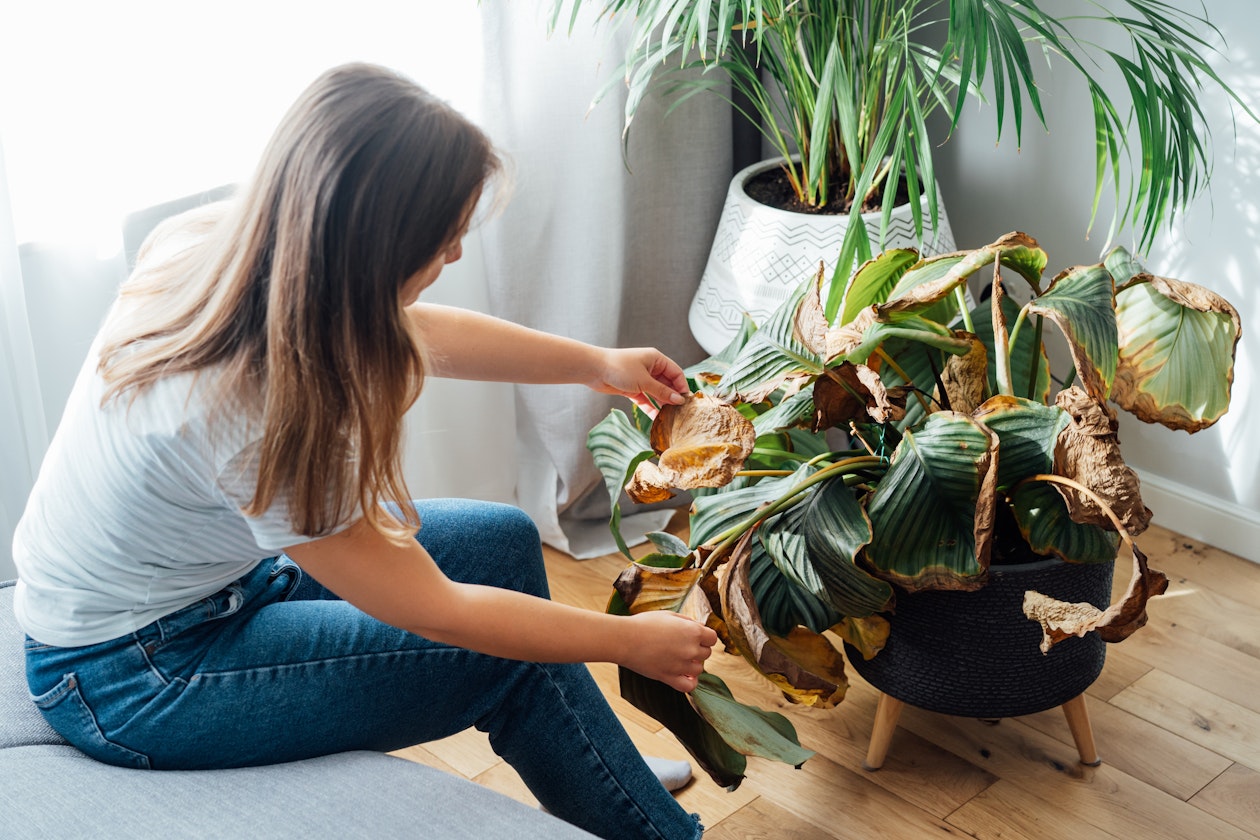
- Home
- Calathea - Are They Really an Easy Care Houseplant?
Houseplant Myth Busters
Calathea - Are They Really an Easy Care Houseplant?
10th September 2024
Jonathan Davies

Are Calatheas really an easy care houseplant?
You’re in the garden centre, admiring their “easy care” section. They have the usual plants:Epipremnum, Zamioculcas, Sansevieria, etc., and everything is looking very healthy and tempting! That’s when you spot it. The most outrageously beautiful plant, with large medallion leaves and beautiful patterns of silvery white and bold pink. Their leaves drape over the crown forming the perfect shape for that empty space on your bookshelf. It is labelled: “Calathea”. “And in the easy-care section too. This is a no brainer” you think to yourself, cheerfully picking up the nicest specimen and heading for the till. And there it sits, on that perfect spot on your bookshelf… each day going browner and browner, crispier and crispier. The new growth coming out shrivelled and malformed, the old growth looking limp and yellow. That’s when it hits you… this is not an easy care plant.
Unfortunately, Calatheas are not easy-care plants. Their striking colours and high availability makes them a popular choice for houseplant keepers, and quite often they do not come with a disclaimer regarding their fussy needs. Due to their high selling potential, they are often noted as ‘easy-care’ plants, but they should be approached with caution. However, Calatheas are undoubtedly a good plant to keep and if looked after correctly can yield some very rewarding results.
What are Calatheas?
Calatheas are flowering plants of the Marantaceae family. A large number of Calatheas were reclassified as Goeppertia in 2012, including those commonly kept as houseplants. The use of Calathea as a synonym is still its most popular name. They are well known for their leaves that come in a variety of colours and shapes and patterns.

Why are Calatheas not easy-care plants?
Truthfully, it depends on what you consider an easy care plant. Some plants require different care, but are easy when you have internalised the practice to the point of habit. Others thrive off neglect and just grow without you even doing anything. Calathea require specific needs that do not particularly align with other common houseplants, and they are susceptible to certain things that make it difficult to gain success from just popping them in a spot and watering them occasionally.
Watering: While it is debated to what extent this is a necessity, some Calatheas do not respond well to UK tap water. Tap water contains stuff that calatheas are quite sensitive to like various salts, minerals and chemicals like fluorine that can build up in the soil. This causes the minerals to be deposited in the end of the plants extremities, causing scarring and crispy leaves.
Light: Calathea grows on the forest floor of South American rainforests. The forest floor allows small rays of light to pass through gaps in the trees and hit small pockets of space for short periods of time, while allowing a low to medium level of background light throughout the day. Unfortunately, in the home the intensity of direct sunlight is far too much for a calathea, while the medium to low light spots in our homes are likely too little. It is hard to mimic these conditions without moving the plant around, which as an act in itself can be stressful for the plant.
Humidity: Calathea have evolved to grow prolifically in moist conditions, with the humidity in their environment reaching areas of 50/60% and the temperature sitting at around 25 degrees for a long portion of the year. Unfortunately, in the home these are unachievable conditions, and solutions like misting and pebble trays have been shown to not really help at all.
Temperamental: As well as being incredibly fussy with their needs, Calatheas do not seem to have a very strong will. While a small amount of suffering is unlikely to instantly kill your Epipremnum or Sansevieria, it does not take very long at all for Calatheas to show signs of distress, and quite often it is very difficult to reverse once starting.
Pests: Unfortunately, Calathea are not very well adapted to dealing with spider mites. They lack the necessary chemical defences and their leaves are soft enough for the mites to bite through, as a result they have become notorious for being quite susceptible to spider mite infestations. I myself have dedicated years to a Calathea roseopicta cutting only to have it devoured by spider mites once it had finally become an established plant.
How do I keep my Calathea healthy?
So you’ve read all the above and still decided you want it? You have my respect. Here are some brief care tips to help you do the best you can to keep your Calathea looking fresh:
Watering: Try to water as the top few inches of soil get dry. Check the weight of your plant to determine if there is water being held at the bottom. For Calathea it is generally recommended to use distilled water or filtered water, not tap water. When watering, try not to use too much. It is far better to have to water more often with less water than to drench it. Finally, it is not recommended to have Calathea potted without drainage holes, as the tiniest amount of unnecessary water retention will kill it very quickly. Instead, keep it in a nursery pot or terracotta, inside a ceramic pot cover if you want. Ensure that you see the water draining out of the bottom while you water it, and then pop it back in its place when you are satisfied that it has had enough. Reduce watering significantly in the winter.
Light: Even though it is difficult to nail the light conditions for Calathea in the UK, the best alternative is to place it in bright direct light, and if it gets a minute amount of full sun (around 1 hour in the morning or evening) it will likely benefit. A calathea will not be able to handle the full heat of the midday sun.
Feeding: Feeding Calathea should be done with caution, as they display nutrient burn quite vividly. Feed your Calatheas every other watering during periods of active growth. If you can, use a well balanced fertiliser, as Nitrogen or Potassium promoting ones may be too much for it. Stop feeding altogether over the winter unless your plant is in controlled conditions.
Soil: It is important to pot a Calathea with a good, well draining soil mix that includes a number of grain sizes. I recommend a base of coco coir with perlite or pumice, to aid drainage and to stop the soil from fusing, and pine bark, to aid in water regulation and add to the chunkiness of the mix.
Other: Calatheas are also quite physically delicate, and being bashed around can cause surface damage. Try not to keep your calathea in a heavy traffic area, and ensure you don’t spend too much time fussing over the leaves, especially the soft and malleable new growth which is most susceptible. To keep calathea looking fresh, damaged or ugly leaves can be snipped off from the base of the petiole, but try not to take off too much at once. If your calatheas stress is under control, then removing one sad leaf a week should allow it to adjust happily.

Alternatives to Calathea:
If I have put you off, I’m sorry. But I’m certainly saving you a lot of heartbreak. There are many plants of similar beauty that require less complex care as alternatives though, so you can still keep unique and attractive plants. Some of these are plants from the same family, so are not very dissimilar at all, but all in all require much less work.
Marantaceae alternatives:
Maranta: Maranta or “Prayer Plants” have jagged geometric vines and lovely spoon shaped leaves with a purple underside that move up and down each day and night. They come in a large variety of colours, and often host very delicate patterns of reds, greens and purple. They are much easier to keep than Calathea and often grow faster too!
Ctenanthe: Ctenanthe have only recently been reclassified out of the Calathea genus, so visually they are very similar. Quite often, Ctenanthe have long, ovoid leaves that are a little firmer and sturdier than Calathea. They still have those lovely coloured petioles, lovely red undersides and lovely patterned leaves, but without all the fuss of a Calathea.
Easier Calathea:
Calathea orbifolia: C.orbifolia is a large leafed, all-green calathea, which has larger and sturdier leaves than the colourful varieties. It has really nice mint coloured stripes on each leaf and when grown, looks very full and satisfying. It is not as simple as Maranta or Ctenanthe for care.
Calathea makoyana: C.makoyana is a smaller variety that still demonstrates the beautiful colours and patterns of the more popular varieties. Again, this plant is still more work than your standard houseplant but is a little easier to handle than other Calathea.
Calathea lancifolia: C.lancifolia is a long-leaved variety of Calathea with green leaves with red undersides. They often boast darker green patterns on the leaves, and have sturdier leaves than their ovular counterparts. Again, this plant is still more work than your standard houseplant but is a little easier to handle than other Calathea.
Non-Marantaceae alternatives:
If I have put you off the entire family, I am really sorry. That was not my intention, but if your mind is firmly made up and you want nothing to do with anything even remotely close to Calathea, I have some stunning alternatives for you to look at that match the bright colour and stunning shape of Calathea. Where in brackets it says ‘species’ it refers to a specific plant, while ‘genus’ means that a large number of the plant’s immediate relatives are recommended at once, and you should take a look at them as a whole!
(genus) Aglaonema
(genus) Anthurium
(genus) Philodendron
(genus) Begonia
(genus) Tradescantia
(genus) Peperomia
(species) Plectranthus scuttelarioides (Coleus)
(species) Codiaeum variegatum
Jonathan Davies
Jonny has worked at Root since May 2023. His love for plants was inherited initially from his grandparents and parents, but really took off once he moved into his own place, where he started picking up small plants and was fascinated by watching how they grow and change over time. Jonny has a degree in Archaeology and Classics from the University of Sheffield, and a masters in Egyptology from Swansea University, where he primarily focused on garden culture in the ancient world, which he has managed to extend to a PhD thesis in the University of Liverpool, where he has been able to combine his love for plants with his love for ancient language and culture. Jonny loves being in the natural spaces around North Wales and Cheshire where he used to go growing up, and often spends hours examining the plants and trees, and kicking up the leaf litter searching for mushrooms and insects. He is fascinated most by plant biology, taxonomy and learning about ecosystems and interactions between plants and their environmental counterparts, and enjoys tending to his varied array of houseplants, and ongoing ‘plant projects’, such as growing plants from seeds and creating living epiphyte displays. Aside from his green thumb, his other interests include: art, reading, listening to and playing music in the company of his cats, Spooky and Boo.
More by Jonathan DaviesRelated Articles
View all articles
